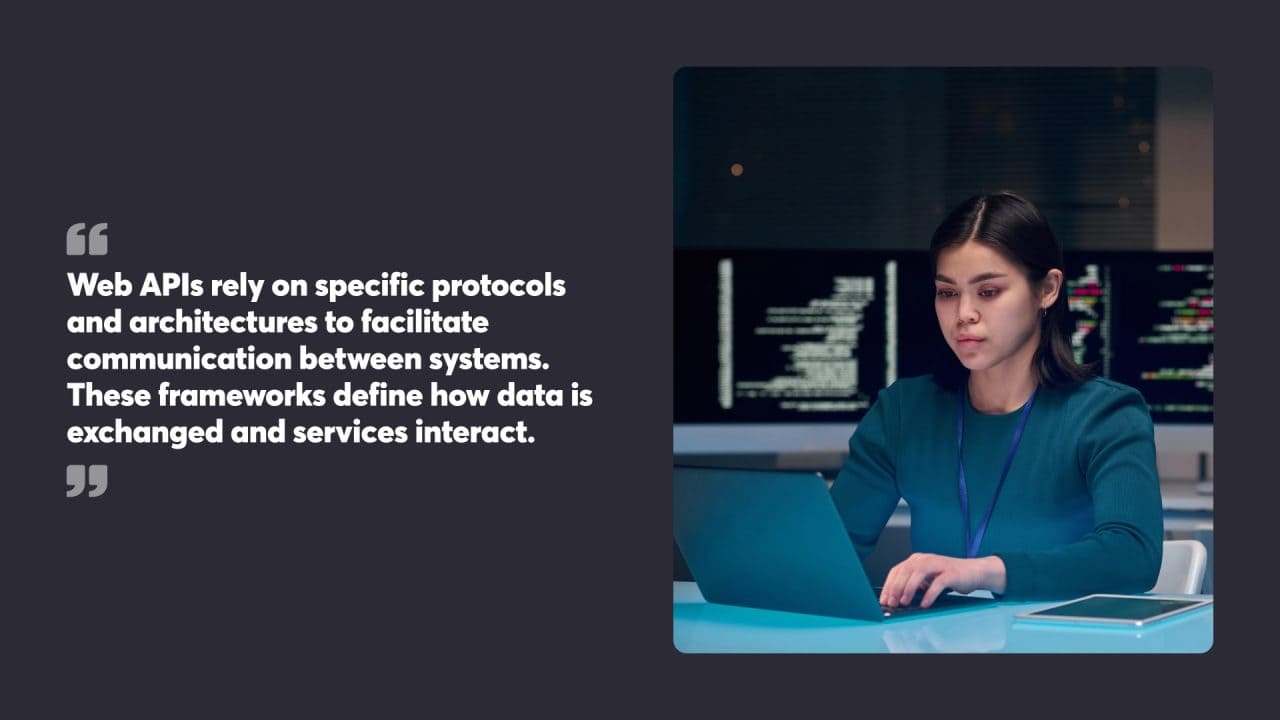
Web APIs serve as digital connectors, enabling different software applications to communicate and share data seamlessly. These interfaces form the backbone of modern web services, allowing developers to integrate diverse functionalities into their applications without reinventing the wheel. Web APIs facilitate the exchange of information between systems, fostering innovation and enhancing user experiences.
APIs simplify complex processes by providing standardised methods for accessing data and services. They act as intermediaries, allowing applications to request and receive information from external sources. This capability opens up a world of possibilities for developers, who can leverage existing services to create feature-rich applications more efficiently.
Key Takeaways
- Web APIs serve as digital bridges, enabling seamless communication and data exchange between different software applications, fostering innovation, and enhancing user experiences across various platforms and services.
- Web APIs simplify complex processes by providing standardised methods for accessing data and services, allowing developers to leverage existing functionalities and create feature-rich applications more efficiently.
- Integrating Web APIs into applications streamlines development processes, promotes code reuse, and facilitates the creation of ecosystems around products or services, driving business growth and flexibility.

Table of Contents
Understanding Web APIs
Web APIs play a crucial role in modern software development, enabling communication between different applications and services. They facilitate data exchange and integration across diverse platforms and systems.
Defining Application Programming Interfaces
Application Programming Interfaces (APIs) are sets of protocols, tools, and definitions that allow software components to interact with each other. Web APIs, a specific type of API, operate over the internet using standard web protocols like HTTP. These interfaces act as intermediaries, allowing different software applications to request and exchange data seamlessly.
Web APIs typically use standardised formats such as JSON or XML to structure data. They follow specific rules and conventions, making it easier for developers to integrate external services into their applications. Common types of Web APIs include REST (Representational State Transfer) and SOAP (Simple Object Access Protocol), each with its own architectural style and data exchange methods.
The Role of Web APIs in Service Connectivity
Web APIs are essential for connecting various services and applications across the internet. They enable developers to access functionalities and data from remote servers without needing to understand the underlying implementation details. This abstraction simplifies the development process and promotes code reuse.
By leveraging Web APIs, applications can retrieve real-time data from external sources, process payments, authenticate users, and perform numerous other tasks. For example, a weather app might use a meteorological service’s API to fetch current weather data, while a social media platform could use APIs to integrate with third-party services for sharing content.
Web APIs also support the development of microservices architectures, where complex applications are built as a collection of smaller, independent services. This approach enhances scalability and flexibility in software development.

Core Components of Web APIs
Web APIs consist of several key elements that enable seamless communication between different software systems. These components work together to facilitate data exchange and integration across diverse platforms and applications.
API Endpoints and HTTP Requests
API endpoints serve as the interface points for accessing specific resources or functionalities within a web service. They are typically represented by unique URLs that define the location of the resource. When a client application needs to interact with the API, it sends an HTTP request to the appropriate endpoint.
HTTP requests form the basis of communication between clients and servers in web APIs. These requests include various methods such as GET, POST, PUT, and DELETE, each serving a distinct purpose. GET retrieves data, POST creates new resources, PUT updates existing ones, and DELETE removes specified items.
Endpoints often accept parameters to refine or filter the requested data. These parameters can be included in the URL itself or sent as part of the request body, depending on the API’s design and the specific operation being performed.
Data Formats: JSON and XML
JSON (JavaScript Object Notation) and XML (eXtensible Markup Language) are the two primary data formats used in web APIs for structuring and transmitting information.
JSON has gained widespread adoption due to its simplicity and ease of use. It employs a lightweight, text-based format that is both human-readable and machine-parsable. JSON uses key-value pairs and arrays to represent data structures, making it highly compatible with many programming languages.
XML, while less common in modern APIs, remains relevant in certain industries and legacy systems. It uses tags to define elements and their relationships, offering more flexibility in data representation. XML supports attributes and namespaces, allowing for more complex data structures.
Both formats support nested structures, enabling the representation of hierarchical data. The choice between JSON and XML often depends on factors such as compatibility requirements, data complexity, and developer preferences.
API Keys and Access Tokens
API keys and access tokens play a vital role in securing and managing access to web APIs. These authentication mechanisms help identify and authorise clients, control usage, and protect sensitive data.
API keys are unique identifiers assigned to developers or applications. They are typically included in the request headers or as query parameters. API keys help track usage, enforce rate limits, and provide basic access control.
Access tokens offer a more advanced form of authentication, often used in OAuth 2.0 implementations. They are temporary credentials granted after a user authenticates and authorises an application. Access tokens carry specific permissions and can be revoked or refreshed as needed.
Both API keys and access tokens help API providers monitor and control usage, prevent abuse, and implement tiered access levels. They also enable developers to build secure applications that interact with APIs while protecting user data and maintaining privacy.

Protocols and Architectures
Web APIs rely on specific protocols and architectures to facilitate communication between systems. These frameworks define how data is exchanged and services interact.
HTTP and REST Principles
HTTP forms the foundation for most modern web APIs. This protocol enables client-server communication through a request-response model. REST (Representational State Transfer) builds upon HTTP, providing a set of guidelines for creating scalable web services.
REST APIs use standard HTTP methods like GET, POST, PUT, and DELETE to perform operations on resources. These resources are identified by URLs, making REST APIs intuitive and easy to use. RESTful services typically exchange data in JSON or XML formats, which are lightweight and widely supported.
One key principle of REST is statelessness. Each request from a client must contain all the information needed to process it, without relying on server-side session data. This approach enhances scalability and simplifies server implementation.
SOAP APIs: A Different Approach
SOAP (Simple Object Access Protocol) offers an alternative to REST for building web APIs. Unlike REST, which is an architectural style, SOAP is a protocol specification with stricter rules.
SOAP APIs use XML for message formatting and can work over various transport protocols, though HTTP is the most common. They rely on Web Services Description Language (WSDL) files to define available operations and data types.
SOAP messages have a standardised structure with elements like an envelope, header, and body. This structure allows for more complex operations and built-in error handling. While SOAP can be more verbose than REST, it offers features like WS-Security for enterprise-level applications that require advanced security measures.

Integrating APIs in Applications
API integration enables applications to exchange data and functionality seamlessly. It forms the backbone of modern software development, allowing diverse systems to work together efficiently.
API Tools and Libraries
API integration tools streamline the process of connecting different software systems. Popular options include Postman, which simplifies API testing and documentation. Developers often use language-specific libraries like Requests for Python or Axios for JavaScript to handle HTTP requests and responses.
These tools offer features such as automatic authentication, error handling, and data parsing. They save time and reduce the complexity of working with APIs. Some platforms provide visual interfaces for creating API workflows without extensive coding.
Working with Third-Party APIs
Third-party APIs extend an application’s capabilities by tapping into external services. When integrating these APIs, developers must first obtain API keys or tokens for authentication. They then study the API documentation to understand available endpoints, request formats, and response structures.
Best practices include rate limiting to avoid overloading the API, implementing caching to reduce unnecessary calls, and handling errors gracefully. Developers should also consider versioning to manage API changes over time.
Security is paramount when working with external APIs. Encryption of sensitive data and secure storage of API credentials are essential. Regular updates to integrated APIs help maintain compatibility and access to the latest features.
Making API Requests
API requests form the core of interacting with web services. These requests allow applications to send and receive data, enabling seamless integration between different systems and services.
Using HTTP Methods
API requests typically use standard HTTP methods to communicate with servers. GET requests retrieve data from a specified resource, while POST requests submit new data to be processed. PUT requests update existing resources, and DELETE requests remove specified data.
Each method serves a distinct purpose in API interactions. GET is used for fetching information, such as user profiles or product details. POST creates new records, like adding a customer to a database. PUT modifies existing data, such as updating a user’s email address. DELETE removes specified resources from the server.
Developers choose the appropriate HTTP method based on the desired action and the API’s design. Proper use of these methods helps maintain consistency and follows REST principles, making APIs more intuitive and easier to work with.
Handling Request and Response Data
When making API requests, developers must format the data correctly. Request data often includes parameters, headers, and sometimes a request body. Parameters can be part of the URL or sent separately, depending on the API’s requirements.
Headers contain additional information about the request, such as authentication tokens or content type specifications. The request body, used mainly in POST and PUT requests, carries the data to be sent to the server.
After sending a request, the API returns a response. This response includes a status code indicating success or failure, headers with metadata, and often a response body containing the requested data or error details.
Parsing the response data is crucial for extracting useful information. Many APIs return data in JSON format, which can be easily converted into programming language objects for further processing.

API Security and Best Practices
API security safeguards sensitive data and maintains user trust. Proper documentation and versioning help developers integrate APIs effectively.
Securing API Endpoints
Authentication tokens play a crucial role in protecting API endpoints. These tokens verify user identities and authorise access to specific resources. Implementing OAuth 2.0 or JSON Web Tokens (JWTs) provides robust security measures.
API gateways act as a first line of defence, filtering and monitoring traffic. They can enforce rate limiting to prevent abuse and distributed denial-of-service attacks.
Encryption of data in transit using HTTPS is essential. This protects against eavesdropping and man-in-the-middle attacks.
Regular security audits and penetration testing help identify vulnerabilities. Addressing these issues promptly strengthens the overall security posture.
API Documentation and Versioning
Clear and comprehensive API documentation is vital for developers. It should include detailed descriptions of endpoints, request/response formats, and authentication methods.
API documentation tools like Swagger or OpenAPI Specification make it easier to create and maintain up-to-date documentation.
Versioning APIs allows for backward compatibility while introducing new features. Common versioning strategies include URL versioning (e.g., /v1/endpoint) or using custom headers.
Deprecation policies should be clearly communicated in the documentation. This gives developers ample time to update their integrations when older versions are phased out.
Providing code samples and SDKs in popular programming languages can speed up integration and reduce errors.

Client-Side API Integration
Client-side API integration empowers web applications to interact with external services directly from the browser. This approach enhances user experience by enabling dynamic data retrieval and real-time updates without page reloads.
Fetching Data in Web Pages
Modern web pages heavily rely on API calls to retrieve and display data dynamically. The Fetch API has become the standard method for making HTTP requests from web browsers. It offers a more flexible and powerful alternative to older techniques like XMLHttpRequest.
Developers can use the fetch() function to send requests to APIs and handle responses asynchronously. This allows web pages to update content without refreshing the entire page, creating a smoother user experience.
fetch(‘https://api.example.com/data’)
.then(response => response.json())
.then(data => {
// Process and display the data
})
.catch(error => {
// Handle any errors
});
Modern Browser APIs for Developers
Web browsers provide a wide range of APIs that give developers access to powerful features and device capabilities. These APIs extend the functionality of web applications beyond traditional web page interactions.
Some notable browser APIs include:
- Geolocation API: Allows web apps to access the user’s geographical location.
- Web Storage API: Provides mechanisms to store data locally in the browser.
- Canvas API: Enables dynamic, scriptable rendering of 2D shapes and images.
- Web Audio API: Offers advanced audio processing and synthesis capabilities.
These APIs allow developers to create rich, interactive web experiences that rival native applications. By leveraging these tools, web developers can build sophisticated applications that run directly in the browser.
APIs in Software Development
APIs play a crucial role in modern software development, acting as bridges between different applications and services. They facilitate data exchange and integration, streamlining development processes and enhancing functionality.
Software Intermediaries and Services
APIs serve as software intermediaries, enabling communication between different computer programs and applications. They define protocols and methods for requesting and exchanging data, allowing developers to access specific features or data from external services without needing to understand the underlying code.
By leveraging APIs, developers can incorporate complex functionalities into their applications without building them from scratch. This saves time and resources while promoting code reuse and modular design. APIs also support scalability, as developers can easily add or remove features by integrating or disconnecting external services.
APIs and Business Processes
APIs have become integral to many business processes, enhancing efficiency and enabling new capabilities. They allow organisations to expose their services and data to partners, customers, and internal teams in a controlled manner.
By using APIs, companies can automate workflows, integrate disparate systems, and create new revenue streams through partnerships or by monetising their data and services. APIs also support rapid prototyping and development of new products or features, allowing businesses to respond quickly to market demands.
Furthermore, APIs enable the creation of ecosystems around products or services, fostering innovation and extending the reach of a company’s offerings. This API-driven approach to business processes promotes flexibility, interoperability, and continuous improvement of services.

Real-World API Applications
Web APIs drive numerous applications across industries, enabling seamless data exchange and integration of services. They power essential functionalities in weather services and e-commerce platforms, enhancing user experiences and business operations.
APIs in Weather Services
Weather APIs allow apps and websites to access current conditions, forecasts, and historical data from meteorological sources. These APIs provide real-time updates on temperature, humidity, wind speed, and precipitation. Developers integrate this information into mobile apps, smart home systems, and travel booking platforms.
Weather apps rely on APIs to display localised forecasts and send severe weather alerts. Farming applications use weather data to help growers plan irrigation and harvesting schedules. Airlines and logistics companies incorporate weather APIs to optimise routes and reduce delays.
The Australian Bureau of Meteorology offers an API that supplies official weather data for the country. This service enables businesses and researchers to access accurate, localised information for various weather-dependent decisions and analyses.
E-commerce and APIs
E-commerce platforms utilise APIs extensively to create smooth shopping experiences and streamline operations. Payment gateways integrate via APIs, allowing secure transactions without redirecting customers to external sites. Inventory management systems connect through APIs to update stock levels in real time across multiple sales channels.
Shipping APIs enable online stores to offer accurate delivery estimates and tracking information. Product information management APIs help maintain consistent details across marketplaces. Customer review APIs allow shops to display ratings from third-party platforms, boosting trust.
Many e-commerce sites use recommendation APIs to suggest relevant products based on browsing history and purchase patterns. These APIs analyse user behaviour and product attributes to personalise the shopping experience and increase sales.

Troubleshooting API Issues
API issues can disrupt service integrations and data flows. Effective troubleshooting requires understanding status codes and common errors.
Interpreting Status Codes
Status codes provide crucial information about API responses. 2xx codes indicate success, while 4xx and 5xx codes signal client and server errors respectively.
200 OK means the request succeeded. 201 Created confirms a new resource was made. 204 No Content shows a successful request with no response body.
400 Bad Request points to invalid syntax. 401 Unauthorised indicates missing or incorrect authentication. 403 Forbidden means the client lacks permission for the requested action. 404 Not Found signals the resource doesn’t exist.
500 Internal Server Error reflects a problem on the server side. 503 Service Unavailable suggests temporary overload or maintenance.
Developers should check status codes first when debugging API issues. They offer quick insights into what went wrong.
Common API Errors and Solutions
- Authentication problems often cause API failures. Expired or invalid tokens lead to 401 errors. Developers should verify credentials and refresh tokens as needed.
- Incorrect query parameters can trigger 400 errors. Double-checking parameter names, formats, and values helps resolve these issues.
- Rate limiting may result in 429 Too Many Requests errors. Implementing proper request pacing and adhering to API usage limits prevents this problem.
- Parsing errors occur when the API response format doesn’t match expectations. Developers should validate the response structure and handle different data types appropriately.
- Network connectivity issues can cause timeouts or connection failures. Checking internet connections and API endpoint availability is essential.
- Careful error handling and logging aid in identifying and resolving these common API problems. Regular testing and monitoring help catch issues early.
Web APIs play a vital role in modern website development, enabling developers to create dynamic, interconnected, and feature-rich web applications that leverage the power of external services and data sources.
To ensure your website is at the cutting edge of everything APIs can offer, contact the team at Chillybin today.




